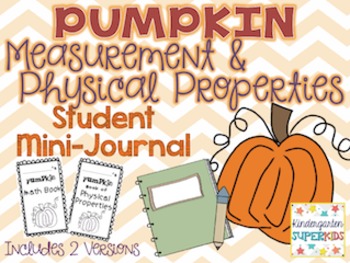Pumpkin Measurement & Physical Properties: Student Mini-Journal
Nora Davis
1.3k Followers
Grade Levels
PreK - 2nd
Subjects
Resource Type
Standards
CCSSK.MD.A.1
CCSSK.MD.A.2
CCSS1.MD.A.1
CCSS1.MD.A.2
CCSS2.MD.A.3
Formats Included
- PDF
Pages
14 pages
Nora Davis
1.3k Followers
What educators are saying
We used this resource for math and science. It was engaging and students were trilled to learn all about the properties of their pumpkin.
Description
Students use small pumpkins for measurement and investigative fun! This product includes two versions of a student mini-journal to use for math, science, or both.
Using the math version, each student will measure his or her pumpkin's length, height, weight, circumference, and will count the seeds inside! The book encourages students to record both their estimates and actual measurement data.
Using the science version, each student will observe his or her pumpkin, use a hand lens to look closely, record how it feels and smells, compare its relative size, compare its weight, measure its length and height, and perform a sink and float experience!
There are 2 book pages per sheet for easy copying and assembly. A page could easily be omitted to shorten the length of the unit. Or mix-and-match the pages from both versions to create a journal that works best for you, your students, and your learning objectives.
Please let me know if I can do anything to improve this product. Leave feedback and visit my blog: www.KindergartenSuperKids.com!
Using the math version, each student will measure his or her pumpkin's length, height, weight, circumference, and will count the seeds inside! The book encourages students to record both their estimates and actual measurement data.
Using the science version, each student will observe his or her pumpkin, use a hand lens to look closely, record how it feels and smells, compare its relative size, compare its weight, measure its length and height, and perform a sink and float experience!
There are 2 book pages per sheet for easy copying and assembly. A page could easily be omitted to shorten the length of the unit. Or mix-and-match the pages from both versions to create a journal that works best for you, your students, and your learning objectives.
Please let me know if I can do anything to improve this product. Leave feedback and visit my blog: www.KindergartenSuperKids.com!
Total Pages
14 pages
Answer Key
N/A
Teaching Duration
N/A
Report this resource to TPT
Reported resources will be reviewed by our team. Report this resource to let us know if this resource violates TPT’s content guidelines.
Standards
to see state-specific standards (only available in the US).
CCSSK.MD.A.1
Describe measurable attributes of objects, such as length or weight. Describe several measurable attributes of a single object.
CCSSK.MD.A.2
Directly compare two objects with a measurable attribute in common, to see which object has “more of”/“less of” the attribute, and describe the difference. For example, directly compare the heights of two children and describe one child as taller/shorter.
CCSS1.MD.A.1
Order three objects by length; compare the lengths of two objects indirectly by using a third object.
CCSS1.MD.A.2
Express the length of an object as a whole number of length units, by laying multiple copies of a shorter object (the length unit) end to end; understand that the length measurement of an object is the number of same-size length units that span it with no gaps or overlaps.
CCSS2.MD.A.3
Estimate lengths using units of inches, feet, centimeters, and meters.





